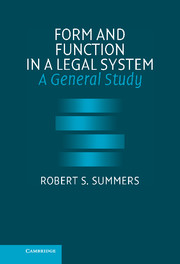Book contents
- Frontmatter
- Contents
- Preface
- Acknowledgments
- PART ONE INTRODUCTION, BASIC CONCEPTS AND DEFINITIONS, AND A GENERAL APPROACH
- PART TWO THE FORMS OF FUNCTIONAL LEGAL UNITS
- 4 Forms of Institutions – Legislative
- 5 Forms of Precepts – Rules
- 6 Form and Content within a Rule – Continued
- 7 Forms of Nonpreceptual Law – Contracts and Related Property Interests
- 8 Forms of Legal Methodologies – Statutory Interpretation
- 9 Forms of Sanctions and Remedies
- PART THREE THE OVERALL FORM OF A LEGAL SYSTEM AND ITS OPERATION
- Name Index
- Subject Index
9 - Forms of Sanctions and Remedies
Published online by Cambridge University Press: 29 July 2009
- Frontmatter
- Contents
- Preface
- Acknowledgments
- PART ONE INTRODUCTION, BASIC CONCEPTS AND DEFINITIONS, AND A GENERAL APPROACH
- PART TWO THE FORMS OF FUNCTIONAL LEGAL UNITS
- 4 Forms of Institutions – Legislative
- 5 Forms of Precepts – Rules
- 6 Form and Content within a Rule – Continued
- 7 Forms of Nonpreceptual Law – Contracts and Related Property Interests
- 8 Forms of Legal Methodologies – Statutory Interpretation
- 9 Forms of Sanctions and Remedies
- PART THREE THE OVERALL FORM OF A LEGAL SYSTEM AND ITS OPERATION
- Name Index
- Subject Index
Summary
“[J]ustice may need to be secured by force… .”
– J. Finnis“Civilization involves subjection of force to reason and the agency of this subjection is law.”
– R. PoundINTRODUCTION
Law in due form must be created, but once created, it is not self-implementing. This is true of law in the form of precepts such as statutory rules and common law principles, nonpreceptual species of law such as contracts and property interests, and all other varieties of law, whether state-made or privately created. Law must be implemented by its addressees. These include private individuals and entities, and public officials and bodies of all kinds. The law to be implemented must be validly made in the first place, and we have seen how form can figure in this. Valid law must also be accessible and duly communicated, and form is essential here, too. For addressees to implement valid law effectively it must be in form and content suitable for implementation.
In earlier chapters, we saw how form defines and organizes law creating institutions and processes. We also saw how formal records facilitate reliable determinations that purported law to be applied today was validly created in the past. We also saw how choices of well-designed form in rules, in contracts, and in other species of law thus validly created, can contribute to the capacity of addressees to formulate reasons for determinate action and decision arising under such law.
- Type
- Chapter
- Information
- Form and Function in a Legal SystemA General Study, pp. 283 - 302Publisher: Cambridge University PressPrint publication year: 2005



